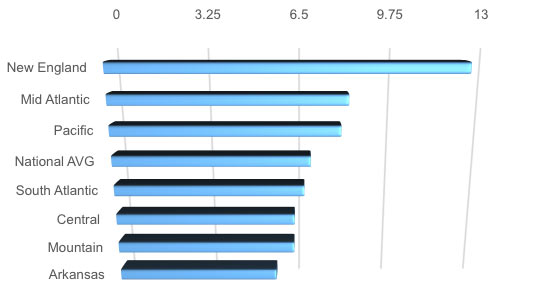
Why Arkansas?
Cost of Doing Business
A company’s cost of doing business directly impacts its bottom line and is a major driver in choosing the location of any new investment. Lower costs mean better margins and higher returns on investment. It’s really that simple. Of the six states that surround Arkansas, only Mississippi has a lower overall average hourly wage for all occupations. Texas has the highest overall average hourly wage of surrounding states – 18 percent higher than the overall average hourly wage for Arkansas.
Annually, CNBC surveys American business and scores each state in the USA by 56 measures of competitiveness. It then groups the resulting metrics into 10 broad categories. In scoring each state’s cost of doing business, CNBC looked at tax burden, including individual income tax, property taxes, and business taxes. In addition, it looked at utility costs, the cost of wages, as well as rental costs for office and industrial space.
Cost of Living
The cost of living helps drive the cost of doing business. From housing to food and energy, wages go further when the cost of living is low. Arkansas was ranked by CNBC 2nd in the nation in 2014 for the cost of living. Arkansas is a bargain – a place where employees are not struggling against odds to stay afloat and can afford to accept a lower wage, given the state’s lower cost of living.
Cost of Industrial Electricity
LOWEST COST STATES FOR INDUSTRIAL ELECTRICITY | |
State | Cents per kWh |
Washington | 4.30 |
Oklahoma | 5.40 |
Montana | 5.45 |
Iowa | 5.61 |
Arkansas | 5.68 |
*Energy costs in Arkansas are ranked as among the lowest in the nation. Arkansas had the 5th lowest price in May 2014 YTD for industrial electricity,
Cost of Industrial Electrictiry in Arkansas at 5.68kWh in 2014 was lower than the average cost in any US Region

According to the Institute for Energy Research, in its 2013 report, “Arkansas: An Energy and Economic Analysis”, “Arkansas has some of the lowest energy prices in the country. Its gasoline price is the 12th lowest among the states. It is also a producer of oil and natural gas. Its natural gas production has quadrupled since 2008 and its oil production increased over 10 percent in just the last year.”
The state of Arkansas has a balanced portfolio of energy sources to keep consumption costs low.
In addition, Arkansas has found new sources of power. Shale gas in the United States is rapidly increasing as a natural gas source with new applications of hydraulic fracturing technology and horizontal drilling. In 2011, natural gas consumption increased in Arkansas with higher availability and lower market costs. The industrial sector in Arkansas consumed 32 percent of the state’s total natural gas consumption. And, the state’s electric utility sector consumed the largest share—40 percent (U.S. Energy Information Administration). In addition to gas, new sources of oil have been recently discovered in the Lower Smackover Brown Dense formation – an unconventional oil reservoir found in southern Arkansas and northern Louisiana.
Workforce
CNBC ranked the Arkansas workforce in 2014 as 19th best in America. What does the CNBC ranking mean? Here is how they explain it: “Many states point with great pride to the quality and availability of their workers, as well as government-sponsored programs to train them. We rated states based on the education level of their workforce, as well as the numbers of available workers. We also considered union membership. While organized labor contends that a union workforce is a quality workforce, that argument, more often than not, doesn’t resonate with business.
Wage and energy costs are a big part of the ranking earned by Arkansas. Wages in Arkansas were, on the average, 53% lower than the national average.
Avg Manufacturing Pay in Arkansas and the USA
Location | Annual 2010 | Annual 2011 | Annual 2012 | % Greater |
Arkansas – South Arkansas | 36,928 | 37,777 | 39,563 | 0% |
Arkansas – Statewide | 39,375 | 40,512 | 41,741 | 6% |
US – National | 57,526 | 59,210 | 60,491 | 53% |

